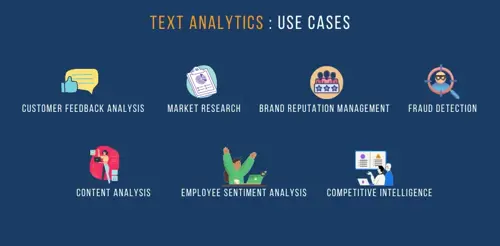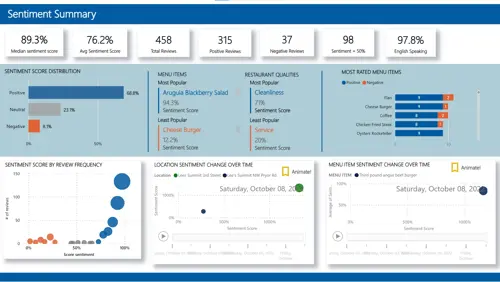AI is causing a paradigm shift in the field of business intelligence. Companies that leverage AI to analyze data gain deeper insights into their customers, operations, and markets, and make data-driven decisions that improve performance and competitiveness. Power BI's AI Insights feature enables users to effortlessly integrate AI-powered visualizations into reports.
AI-powered analytics allow companies to reveal concealed patterns and relationships in their data, thereby gaining a better comprehension of their customers and promptly identifying growth and improvement opportunities. By combining self-service with AI-driven insights, business users across all levels are empowered to make data-driven decisions with increased speed and confidence.
By incorporating AI capabilities, these platforms can produce insights that are more accurate and actionable, leading to improved decision-making and better overall performance in a range of areas, including sales, marketing, and operations. Microsoft Power BI is widely considered a leading platform in this field due to its comprehensive product roadmap and widespread market adoption.
AI is causing a paradigm shift in the field of business intelligence. Companies that leverage AI to analyze data gain deeper insights into their customers, operations, and markets, and make data-driven decisions that improve performance and competitiveness. Power BI's AI Insights feature enables users to effortlessly integrate AI-powered visualizations into reports. Its machine learning algorithms analyze data and deliver actionable insights for better decision-making. In this 2-part series, we explore how.
Introducing AI Insights: Bringing AI into PBI
The Microsoft AI portfolio contains a wide range of products and services to help organizations develop, implement, and manage AI solutions. It includes Azure Cognitive Services- a collection of pre-built APIs for natural language processing, computer vision, speech recognition, and more. It is possible to use these Cognitive Services with Power BI to enhance your reports by adding advanced AI capabilities like natural language processing, image, and speech recognition. There are two ways you can do this.
Option #1: Create a Cognitive Services resource in the Azure subscription ad obtain the API key. Use Power Query to connect to the API, retrieve data and create visualizations in your Power BI report. While this option provides the opportunity to bring in several AI capabilities to Power BI, we would recommend it only if you are able to work with the APIs directly.
Option #2: Use Power BI's AI Insights feature to apply certain cognitive services that are “natively integrated” with Power BI. In other words, AI Insights in Power BI, by virtue of its native integration with other Microsoft AI services like Cognitive Services and Azure Machine Learning, has several features that allow users to directly analyze and gain insights from their data, even without knowledge of the underlying API. The AI functions can be called from within Power BI.
With AI Insights in Power BI, you have direct access to Cognitive Services and Microsoft AI services to analyze data and extract insights. AI Insights has two major features:
Text Analytics: This feature provides NLP capabilities to analyze unstructured text data, such as customer feedback or social media posts. You can perform sentiment analysis, extract key phrases, and detect language.
Custom Vision service: This feature allows you to upload images and train a model to recognize objects or patterns. You can then use the trained model to classify new images and extract insights. We will cover Custom Vision in detail in Part 2 of this series. Let’s dive deeper into Text Analytics.
Text Analytics: Features
The Text Analytics feature of AI Insights in Power BI extracts insights from unstructured text data. It has three major capabilities-
Sentiment Analysis: Analyze customer feedback or social media to understand sentiment towards a product or brand and identify pain points and areas for improvement. Each input receives a score sentiment between 0 (negative) and 1 (positive). Scores that are in the middle (0.5) can be considered as neutral.
Key Phrase Extraction: Extract important phrases from customer feedback or social media posts to identify trends, patterns, and customer needs and preferences. It uncovers trends and patterns by extracting important phrases from customer feedback or social media posts.
Language Detection: Evaluate the content and determine the language. For each field, the language name and associated ISO identifier is returned. This is particularly useful in multilingual environments to segment data.
Text Analytics: Use Cases
The Text Analytics feature of AI Insights in Power BI can be used in a variety of business cases to extract insights from images. Some examples include:

Customer feedback analysis:
Text analytics can be used to analyze customer feedback from various sources such as social media, online reviews, and surveys to identify common themes, sentiment, and areas for improvement.
Market research:
Text analytics can help businesses analyze large volumes of unstructured data from sources such as social media, blogs, and forums to gain insights into consumer preferences, trends, and sentiment.
Brand reputation management:
Text analytics can help businesses monitor their brand reputation by analyzing online reviews and social media sentiment, identifying potential issues, and taking corrective action to address negative comments.
Fraud detection:
Text analytics can be used to identify patterns and anomalies in text data that may indicate fraudulent activity, such as in insurance claims or financial transactions.
Content analysis:
Text analytics can be used to analyze large volumes of content, such as news articles, to identify trends, sentiment, and common themes.
Employee sentiment analysis:
Text analytics can be used to analyze employee feedback and sentiment to identify areas for improvement and improve employee engagement and satisfaction.
Competitive intelligence:
Text analytics can be used to analyze competitor data such as product reviews, social media activity, and customer feedback to identify areas where a business can differentiate itself and gain a competitive advantage.
These are just a few examples, but the potential use cases for Text Analytics feature of AI Insights are vast and can be applied to many industries and scenarios like retail, healthcare, and manufacturing improve customer experience, increase revenue, and enhance performance. We will discuss one such use case in the next section.
Text Analytics PoC: Streamlining Restaurant Operations with AI
Recently, we created a PoC for a restaurant business to analyze customer feedback and social media to improve customer experience, increase revenue, and enhance overall performance.
A restaurant business could use this in several ways-
Analyzing customer feedback: Restaurants can use text analytics to analyze customer feedback from various sources, such as social media, online reviews, and surveys, to understand their customers' needs and preferences. By analyzing customer feedback, restaurants can gain insights that help them improve their services and menu offerings.
Identifying key themes and topics: Text analytics can be used to identify common themes and topics that appear in customer feedback. Restaurants can use this information to identify areas for improvement and make data-driven decisions.
Sentiment analysis: Restaurants can use sentiment analysis to analyze customer feedback and determine the overall sentiment (positive, negative, or neutral) of the feedback. This helps the restaurant understand how customers feel about their services and products and take appropriate action.
Menu optimization: By analyzing customer feedback, restaurants can identify popular dishes and ingredients and use this information to optimize their menus.
Competitive analysis: Restaurants can use text analytics to analyze customer feedback about their competitors to identify areas where they can differentiate themselves and improve their services.
Brand monitoring: Text analytics can help restaurants monitor their brand and reputation by analyzing customer feedback and identifying any negative comments or complaints. This allows the restaurant to address these issues promptly and maintain a positive reputation.

The resulting data visualizations provide the restaurant’s stakeholders with a deeper understanding of the underlying data. There is no need to write any M code or understand the inner workings of the ML models before calling the function. Though we did write some DAX formulas to better visualize the results.
One of our key takeaways is with regards to quality of text input. Just like with any other type of data, the quality of the text data being analyzed is critical to the accuracy of the insights generated by Text Analytics. We’ve seen that Text Analytics generally works best with chunks of texts such as long sentences. It would be better to merge rows with short sentences so that they meet that suggestion. In certain cases, grammatical errors or typos didn’t appear to affect the results. Nonetheless, it's important to ensure that the text is properly formatted, free of errors, and relevant to the analysis being performed. Needless to say, that it’s also important to validate the insights and use human judgement to confirm their accuracy.
Business outcomes
AI Insights in Power BI's Text Analytics provides valuable insights to enhance data-driven decision making, performance improvement, and increased competitiveness.
The business outcomes of using AI Insights in Power BI with Text Analytics vary depending on the specific use case. But there are several general business outcomes that can be obtained by implementing text analytics, regardless of the specific industry. Some of the outcomes of analyzing customer feedback include:
Improved customer experience: Identify areas where they need to improve their products or services to enhance the customer experience, leading to increased customer satisfaction, loyalty, and retention.
Enhanced product development: Identify common issues or areas for improvement with their products and take corrective action to better their products and services to meet customer needs.
Increased operational efficiency: Identify common issues that are impacting operational efficiency and take corrective action to streamline processes and reduce costs.
Better marketing and advertising: Gain insights into customer preferences and use this information to develop more effective marketing and advertising campaigns that resonate with their target audience.
Improved brand reputation: Monitor customer feedback and address negative comments or complaints promptly, businesses can maintain a positive brand reputation and attract more customers.
Data-driven decision-making: Identify trends and patterns and make data-driven decisions that lead to better outcomes and increased profitability.
Summary
AI will play a crucial role in analytics and business intelligence (ABI) platforms in the future with advanced capabilities like NLP, computer vision, and deep learning. Integration with IoT and edge computing leads to real-time data analysis and insights. ABI platforms with built-in AI analyze data faster and more accurately, improving decision making. Real-time insights, alerts, and notifications allow organizations to act proactively.
Power BI's AI Insights, with Text Analytics, extract insights from unstructured data to improve products/services, optimize operations, and understand customers better. These tools also reveal patterns and insights that humans may miss, offering new perspectives and business opportunities.
We would recommend using AI Insights in the following scenarios:
When analyzing large datasets: AI Insights can quickly identify patterns, trends, and anomalies in large datasets that may be difficult or time-consuming to spot using traditional analysis techniques.
When exploring new data: AI Insights can help users quickly gain insights and uncover new relationships in data, providing a foundation for further analysis.
When analyzing time-series data: AI Insights can help users identify trends, seasonality, and anomalies in time-series data, which can be useful for predicting future trends and behavior.
In conclusion, Text Analytics in AI Insights is a powerful tool that can help businesses gain valuable insights from unstructured text data. However, it's important to ensure the quality of the text data being analyzed, understand the different types of text analysis available, and approach the insights generated by Text Analytics with a critical eye. By doing so, businesses can make informed decisions based on a deeper understanding of their text data.
Leverage the power of AI Insights in Power BI with our expert team's support. Unlock the full potential of your data and gain valuable insights to drive growth and success for your organization.
In our PoC, we explored how the Custom Vision feature of AI Insights, could help a restaurant business. From identifying influencers who post positive feedback often and promoting them to attract customers, to uncovering popular dishes by extracting frequently mentioned ones in customer feedback or social media posts and adjusting their menu accordingly, the benefits are huge.
Contact us today to learn more about how AI Insights in Power BI can benefit your business.








